An SEO campaign is a structured set of tasks that should lead to better rankings on search engines. If you actively do SEO, you likely engage in SEO campaigns, whether you call it that or not.
But what should the process from campaign idea to evaluation look like? There are often many steps and people involved, so proper planning is needed to achieve effectiveness and the desired outcome.
We’ve run many SEO campaigns, including some unique ones. You’ll learn to navigate the process from start to finish with many examples along the way.
These are the steps we’ll go through:
- Discover and prioritize your SEO opportunities
- Set up an SEO objective
- Outline the process to achieve the objective
- (Re)write the content
- Acquire and build backlinks
- Monitor the results
- Evaluate the campaign
Let’s dive in.
The first rule of planning SEO campaigns is simple. Don’t start if you lack information and data to back up your decisions. You can come up with countless SEO campaign ideas. But without research, you can’t tell which opportunities are worth pursuing and prioritizing.
The research we’re going to dive into will help us estimate the effort needed to run any SEO campaign and its potential impact. This concept can be illustrated by the Impact Effort Matrix:

Now, because an SEO campaign is defined as a set of tasks, we’ll assume that all the ideas will fall into the two quadrants on the right side.
We need two essential sets of SEO data that will help us come up with the SEO campaign ideas and add them into the matrix. Welcome to keyword and backlink research. If you’ve already done this, feel free to skip to the second step.
Keyword research
Keyword research is the process of understanding the language your target customers use when searching for your products, services, and content. It then involves analyzing, comparing, and prioritizing the best keyword opportunities for your website.
Now, I’m not going to dive into the process of keyword research, as we have a whole guide about that. But do note planning and running a campaign is more advanced than just picking a few keywords and writing content about them.
Here are a few use cases that are worth pursuing as an SEO campaign based on keyword data:
Most of these require an outreach campaign on top of the content creation to maximize the potential. That’s where the other set of data comes into play.
Backlink research
Backlink research is the process of understanding what makes websites link to one another in your niche and gathering link opportunities for your own pages. Basically, it’s about getting all the necessary information to grow a strong backlink profile for your website that should lead to better rankings.
A lot of backlink research stems from a sort of SEO competitive analysis. It can be in the form of analyzing intersecting links where you check which websites link to your competitors but not to you. This Link Intersect report can be accessed in Ahrefs’ Site Explorer:
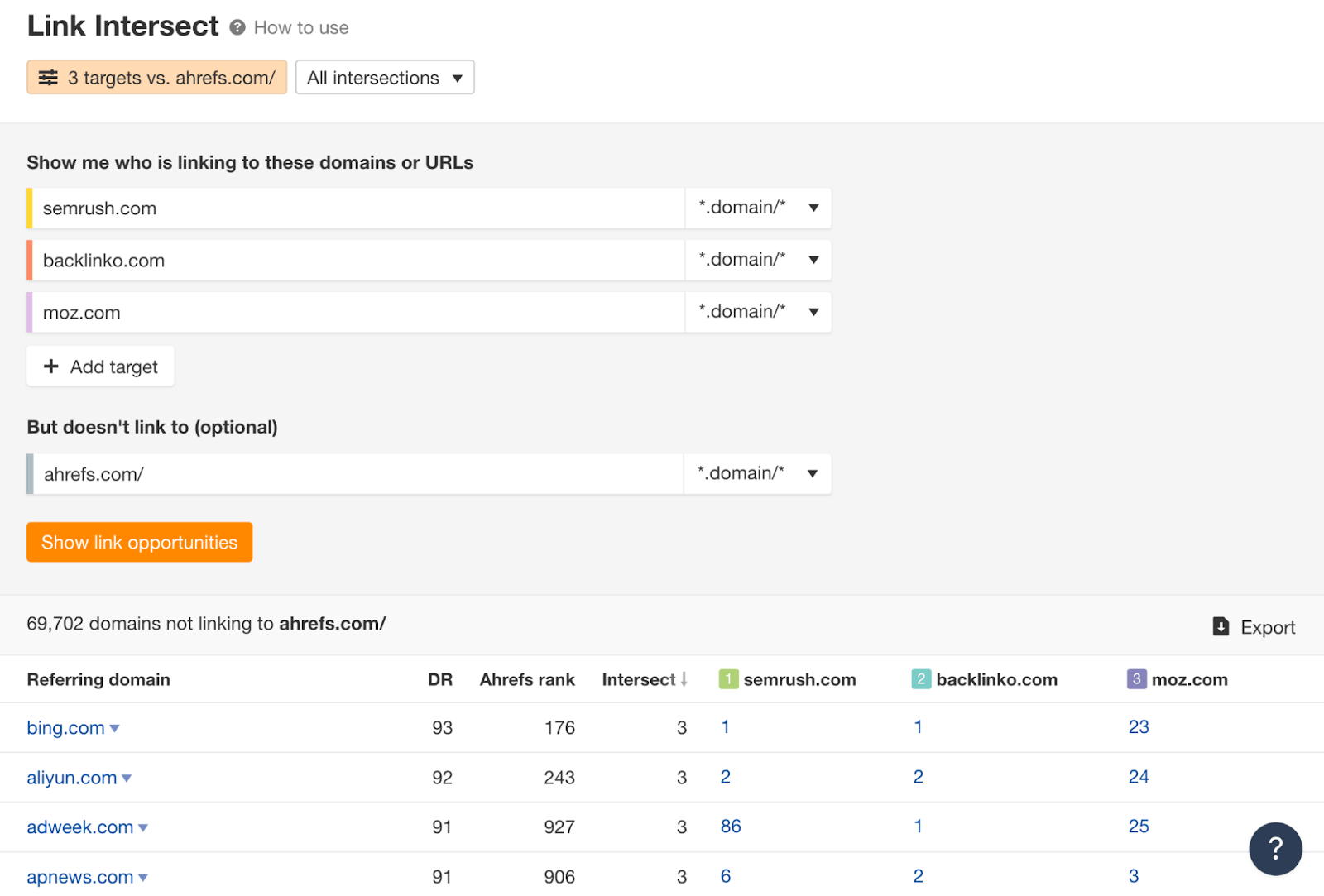
Then we can analyze the type of content that gets the most links (link bait) in your niche in the Best by links report in Ahrefs’ Site Explorer:
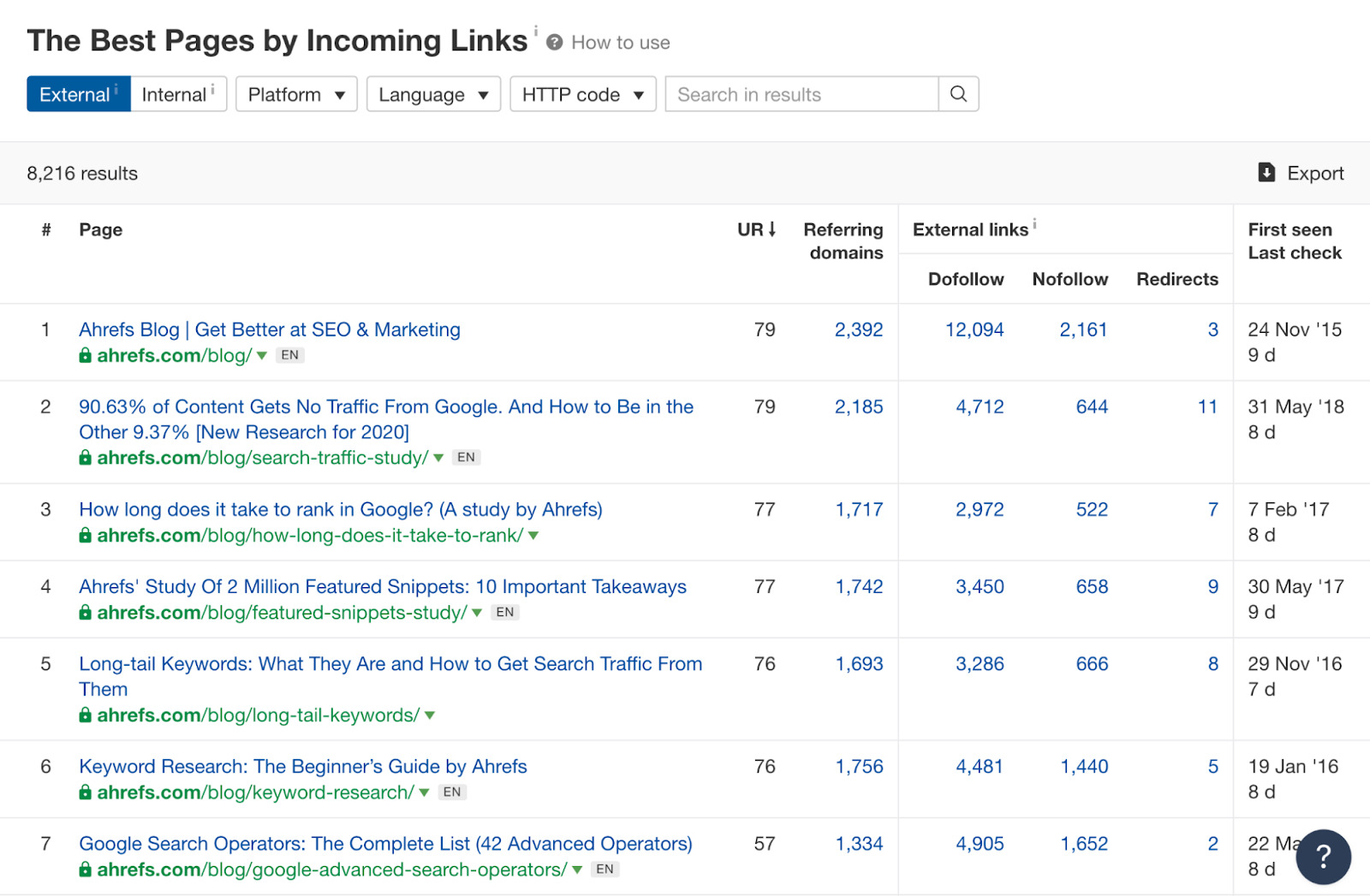
Or do the most straightforward analysis, which is going through the Backlinks and Referring domains reports—all in Site Explorer:
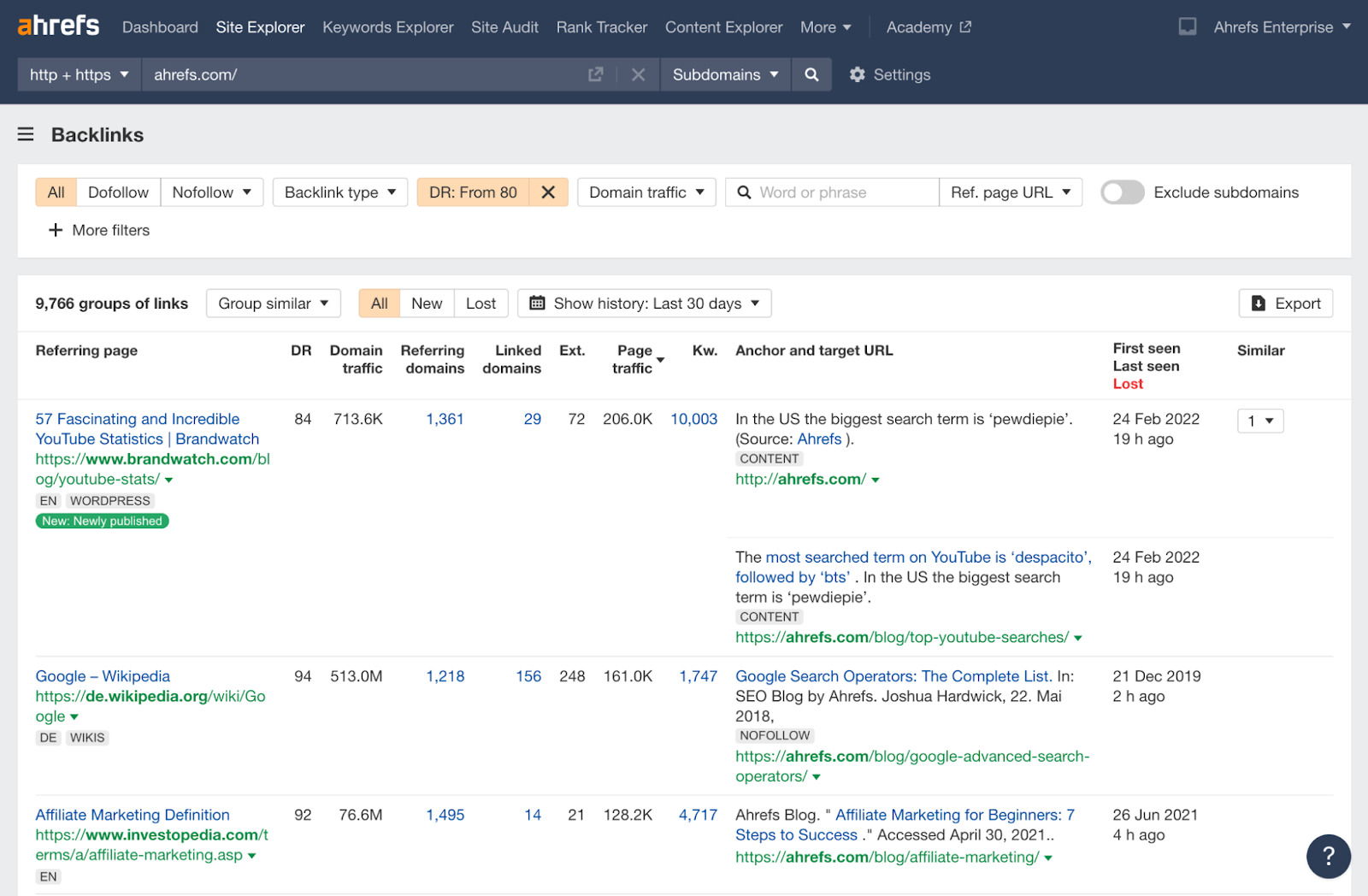
Getting all this research and processes right allows you to launch outreach campaigns that should get high-quality backlinks to your most important pieces of content. Technically, any outreach campaign can be considered an SEO campaign on its own. (Ideally, it’s best to launch it right after the “content creation” step.)
Got an SEO campaign idea that’s worth pursuing? Great! You should set up an objective for that. In other words, what should be the quantifiable outcome of that campaign? What are you aiming to achieve?
Everyone’s SEO objectives are different. But generally, the four most common ones revolve around:
- Increasing conversions and sales from organic traffic.
- Increasing search visibility (share of voice) for a set of keywords.
- Ranking higher for a highly competitive keyword (to outrank a competitor, drive a lot of traffic, etc.).
- Getting high-quality backlinks.
If you’re not sure which objective to choose, these four are always a good starting point.
For example, one of our latest SEO campaigns revolved around creating a “stats” page and then building links to it (to test how successful we’d be so that we could create a case study about it).
The main SEO objective was to rank in the top three for “seo statistics” within three months. Another objective that would help to get us there was to build at least 20 high-quality backlinks to the page from an outreach campaign.
We SEOs can’t really guarantee any results, but these objectives should still adhere to the popular SMART objectives guidelines. You need to find a good balance between the specific, measurable, achievable, relevant, and timely parameters of the objectives.
The time period is arguably the most difficult parameter to estimate. For better ranking objectives, I suggest going for at least three months, preferably even six months and more if your website isn’t generally highly competitive on the SERPs.
Based on our research, only 5.7% of newly published pages get to the top 10 search results within a year. And if they do, it mostly takes between two to six months:
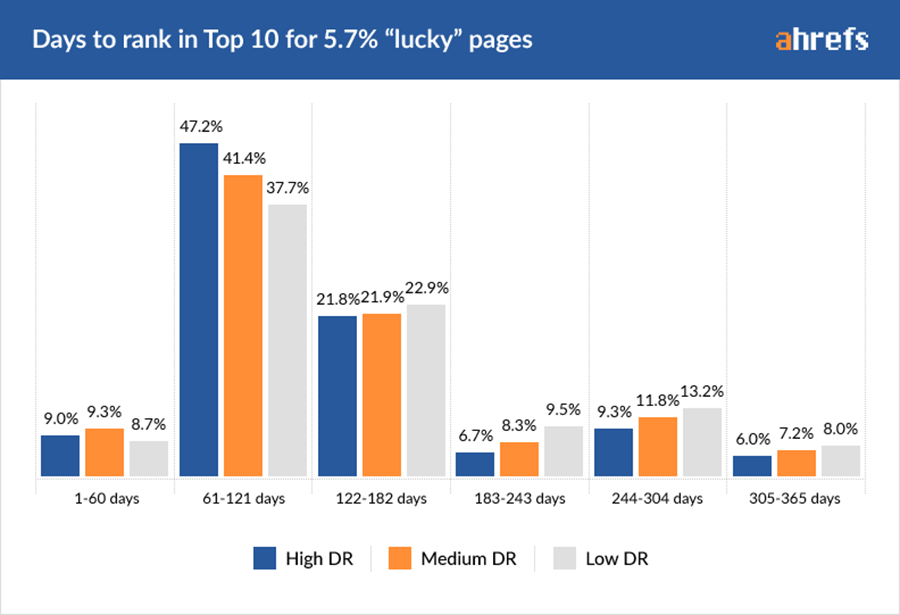
Domain Ranking (DR) shows the strength of a website’s backlink profile compared to the others in our database on a 100-point scale. It’s a solid proxy for assessing how competitive a website can be on the SERPs.
By the way, if your time frame is long enough (six months+), your keyword ranking and backlink objectives may eventually go hand in hand. The better the content’s backlinks, the higher the chances that content will rank well. And the higher a page ranks, the more people will see it and link to it naturally.
Once you know what you’re aiming for with the campaign, it’s time to start planning.
Recommended reading: How to Set the Right SEO Goals With 3 Examples
Let’s now dissect the one big SEO campaign into a structured set of tasks. To help us get there, we’ll use the “SEO goals” pyramid concept:

What we’ve set up in the previous step is the outcome goal and maybe even some performance goals that are evident right away, such as the need to build backlinks. We’re going to uncover the rest of the steps and goals now.
Let’s continue with the example of the SEO campaign for our “stats” page. The outcome goal was to rank in the top three search results for “seo statistics” within three months.
Here, we can tell there are two performance goals that serve as the best way to achieve the outcome goal:
- Write the best SEO statistics page
- Build at least 20 high-quality backlinks to the page via an outreach campaign
The first performance goal is obvious. But setting up the second goal is more nuanced because pages ranking at the top for the most competitive keywords tend to have hundreds, if not thousands, of backlinks earned throughout many years—numbers that you can’t achieve with an outreach campaign.
That’s now largely the case of the “seo statistics” keyword as well. There are pages with thousands of backlinks from thousands of referring domains:
Don’t be discouraged by these numbers, though. Most backlinks come from spammy websites and can be completely disregarded.
Since you should only go after potentially high-quality backlinks, it’s better to look at the whole backlink profile of those pages ranking at the top by clicking on the caret and going over to the Backlinks report:

What I’ve just discovered is the #4 page doesn’t have any backlinks from pages that drive solid organic traffic despite it having thousands of backlinks:
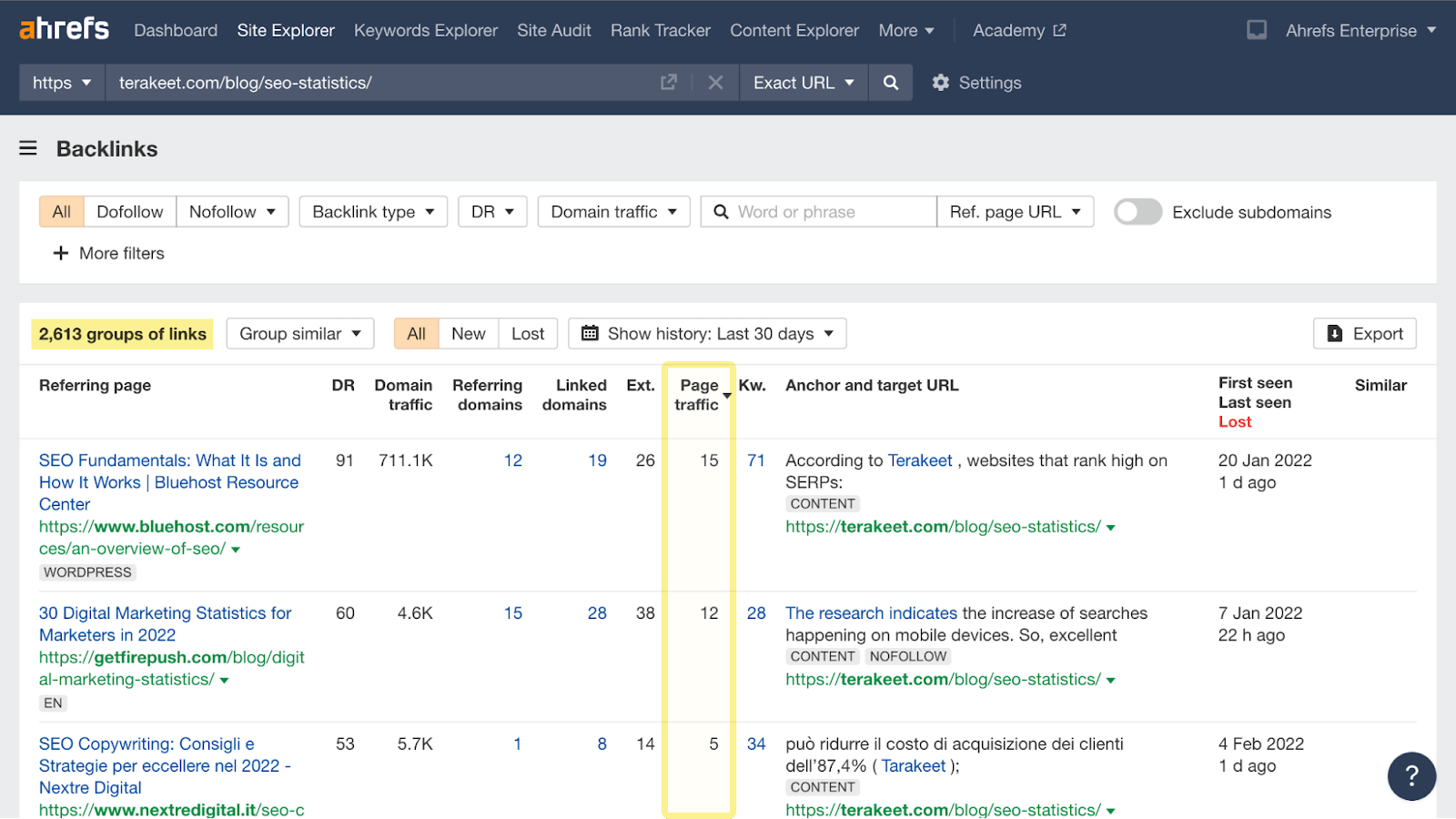
Some other pages there do indeed have hard-to-beat backlink portfolios. But getting to the top of this SERP seems achievable for us within a relatively short period of time.
Based on some basic research, we can see hundreds of link prospects. This makes getting more than 20 acquired backlinks a doable task.
What’s left is to further dissect the performance goals into process goals:
- What do we need to do to write the best SEO statistics page?
- What do we need to do to build over 20 high-quality backlinks?
I already went ahead with the link building aspect, so I’ll stick to expanding on this area. It’s reasonable to expect a 5% outreach conversion rate. This means, on average, we need to reach out to 400 email addresses to get 20 backlinks.
This outreach process may include the following steps:
- Narrow down link prospects to include only high-quality websites with the potential to link to you
- Automatically find and validate email addresses
- Have a convincing reason to reach out (e.g., they were missing some SEO stats or included outdated ones)
- Put it all together into a table for automation purposes and/or tracking your progress
- Write the outreach emails
- Send the outreach emails
- Do follow-ups
If you want to see this process in action, we’ve documented it in a video for the SEO campaign I mentioned earlier:
https://www.youtube.com/watch?v=gMcA-8nalL8
The completed SEO goals pyramid can then look like this:
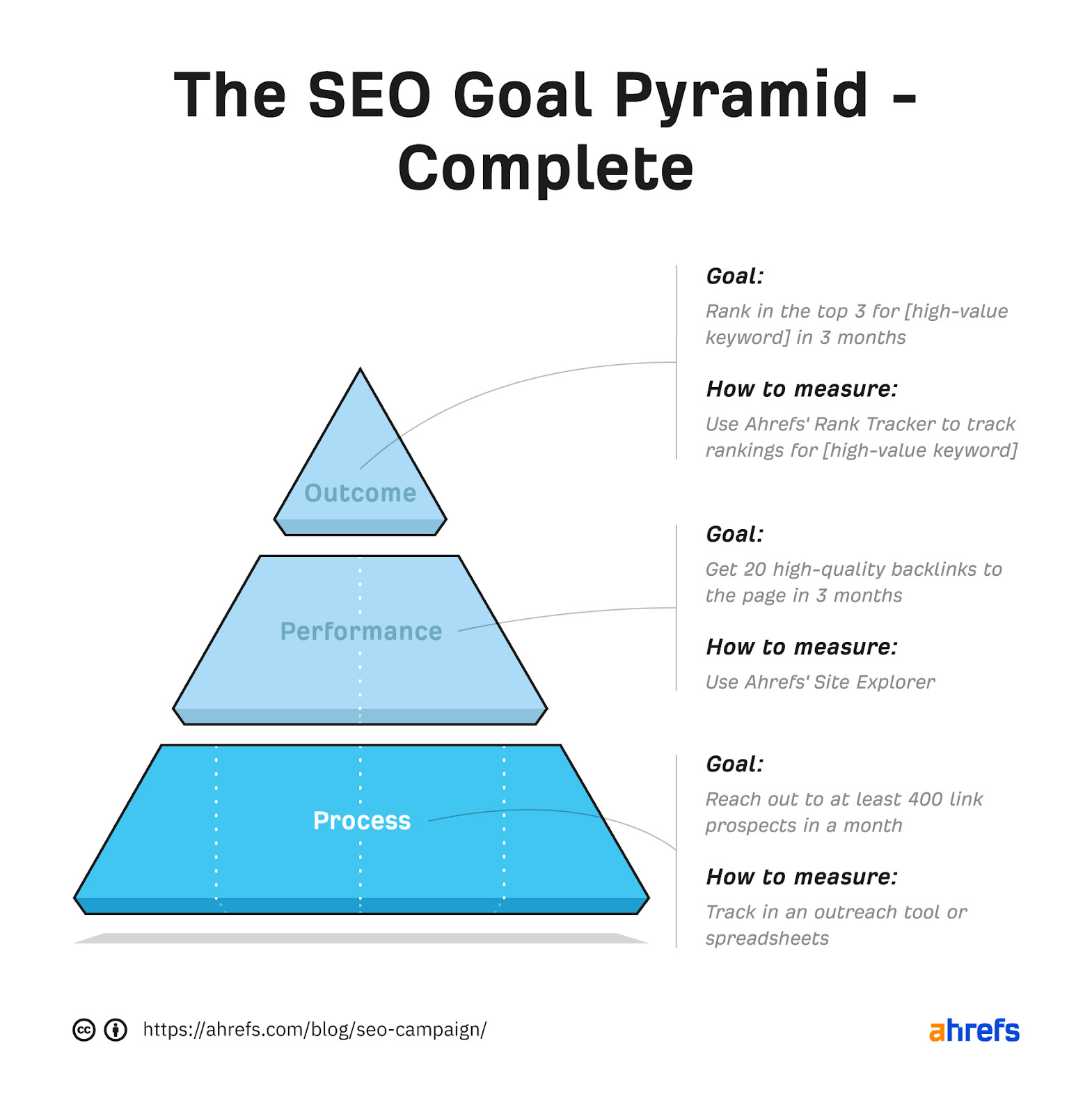
You can also do this for the other performance goals. Now, you’ll have the whole SEO campaign process outlined. You can then start assigning tasks that will take you from start to finish.
As discussed earlier, most SEO campaigns largely revolve around writing or rewriting content. That content should either rank well on the SERPs by itself or at least help your other pages rank by passing link equity from all the attracted backlinks to these pages.
Let’s take a look at a few tips that will help you (re)write both keyword-focused content and link bait content. And if you come across a good keyword that can be covered in a way that will also attract many backlinks, even better—just combine both approaches.
Writing keyword-focused content
I’ll use this very article as an example. We had an older version of this article targeting the keyword “seo campaign” on our blog for a long time, but it never ranked well:

The reason seems evident. When we take a look at the top-ranking pages for “seo campaign,” we see that the vast majority of them are guides. There’s not even one case study in sight:
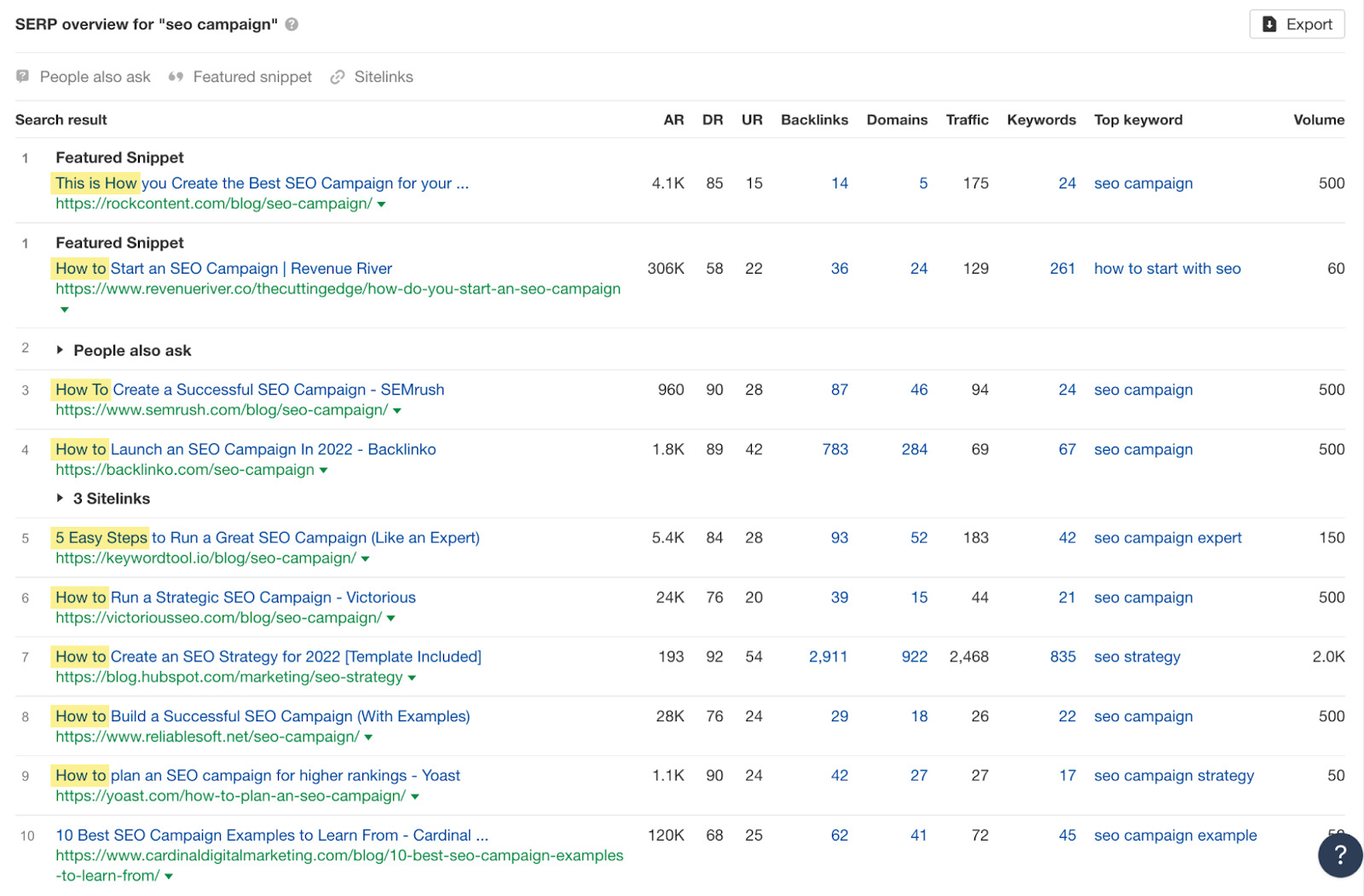
One of the most important aspects of creating content to rank well on search engines is to align with search intent. It’s the “why” behind a search query.
In this case, most people looking up “seo campaign” want to see a guide on how to plan and run one. That’s exactly what this updated version does and why it has a much higher chance of ranking well.
Providing the right angle of the content to the readers is only one of the main aspects we have to take into account here.
For example, before I even write an outline, I think about the goal of the article, the expected search intent, my angle, how I can make it stand out (i.e., USP, which stands for unique selling proposition), and how much I can naturally mention our product (business potential on a scale from 0 to 3):
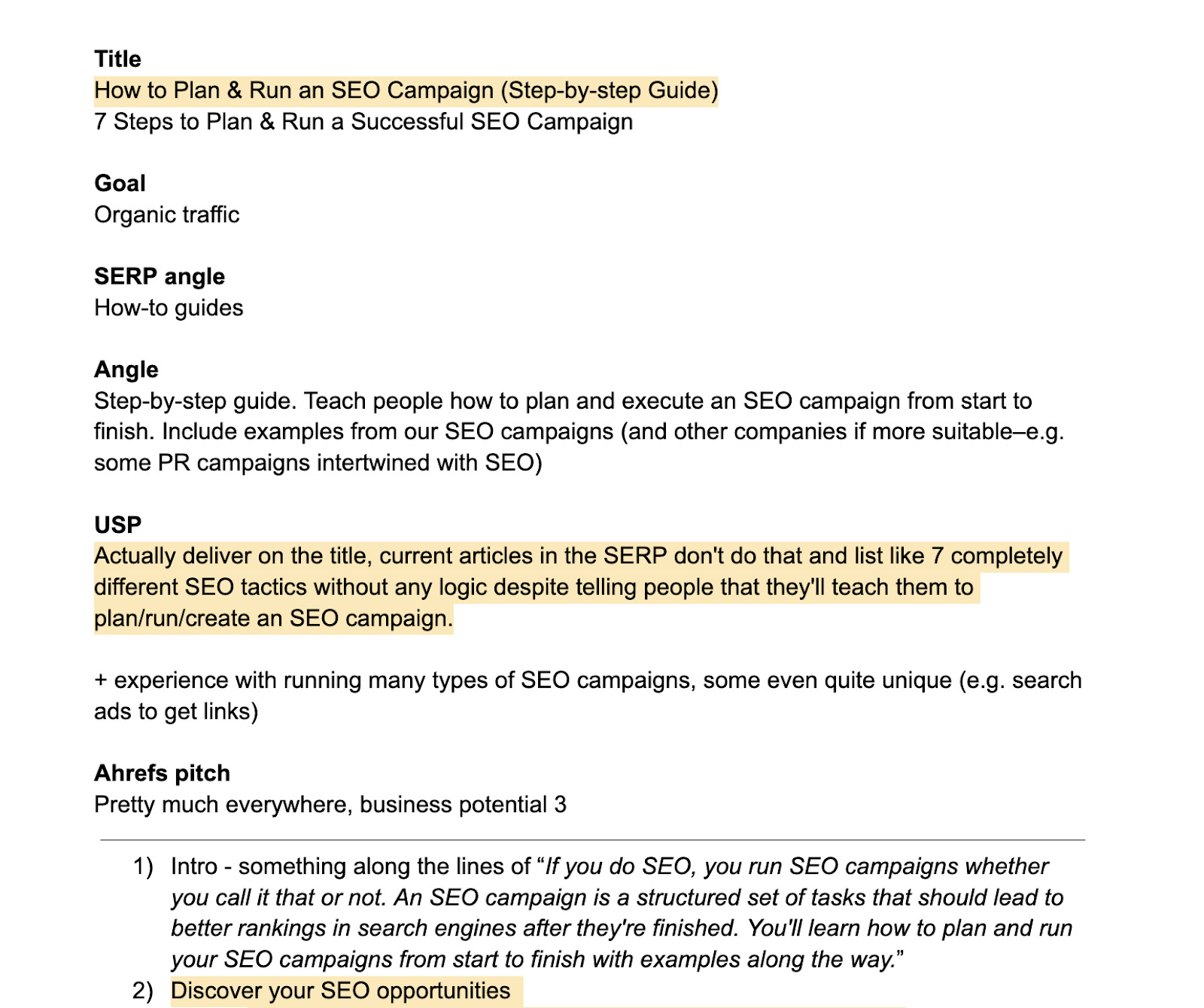
These are all general tips on writing whole pieces of content. You may want to plan and run a more specific type of SEO campaign, such as optimizing for featured snippets in bulk.
Writing link bait content
You should already know what type of content attracts the most links in your niche based on the backlink research mentioned earlier. That’s the easy part. Creating link-worthy content can be quite challenging and often requires a lot of effort.
In the marketing software industry that we’re in, the types of pages that get links most easily are:
- Industry insights and data studies.
- Landing pages with free, ready-to-use marketing tools.
- Statistics pages.
Apart from the statistics pages, it’s close to impossible to develop such content without help from your data science and engineering teams.
But this also means there is a lack of such content types. Thus, having them on your site may result in you getting great links. Make your content the best entry on the SERP to be worth those links.
Recommended reading: Deconstructing Linkbait: How to Create Content That Attracts Backlinks
SEO campaigns rarely end at just publishing content. That’s half of the job. What matters as much as content creation is content distribution that triggers link acquisition.
It’s even more important with link bait content that isn’t made for getting organic traffic. All the work will be in vain without proper content distribution.
Here’s what I mean by proper content distribution:
- Plan an outreach campaign to get backlinks and/or exposure from prominent people in your niche
- Promote the content with social media ads on top of the standard organic social posts that usually have limited reach
- Share it with your email subscribers
- Repurpose your content into social media posts, Quora answers, newsletters, etc., and share repeatedly
- Update your internal links so readers of your other articles can click through and pages can pass their link equities
Of course, the outreach campaign is most relevant for the link building point. Sure, you can get links by simply getting the content in front of many people’s eyes, but it’s the direct email with a specific link building pitch that can get you the results quickly.
We have already looked into the steps and analysis required for planning an outreach campaign and creating link bait content. But we still haven’t discussed the power of public relations (PR) that can take the content distribution and link acquisition to a whole different level.
For example, when I analyzed the SEO strategy of Wise, I found one of the many aspects that stood out is how its creative PR campaigns intertwined with SEO goals.
Here’s its “nothing to hide” campaign, which addresses the issue of hidden fees in finance and banking:
https://www.youtube.com/watch?v=ZufqOLl6ajE
What makes this clearly successful in terms of SEO is the supporting content on its website that attracts some of the links from big media names:
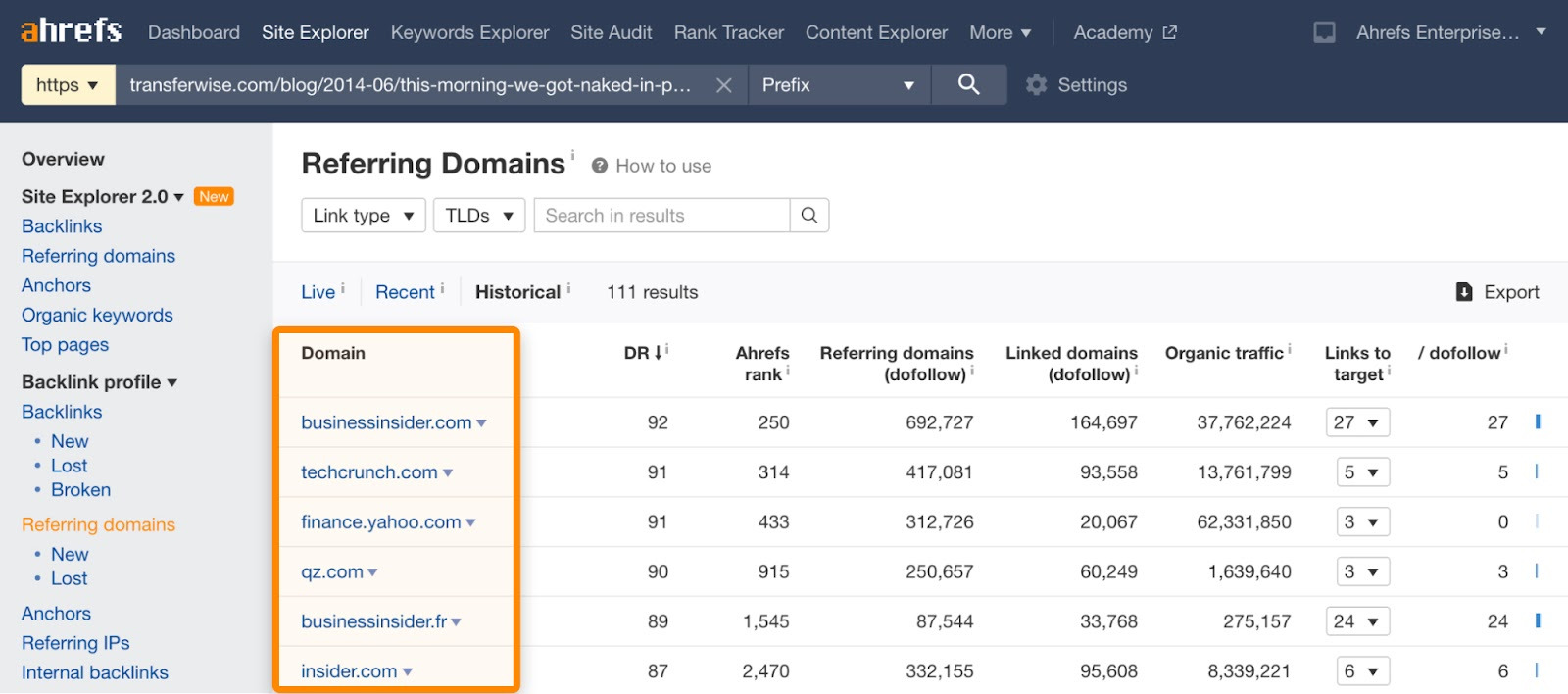
All this being said, there are no limits to link building campaigns. You can choose the good old proven way of attracting links or go with something even more creative as part of a larger PR campaign.
We’re now beyond the tactical execution of the campaign, and it’s time to shift to “analytics” mode. That’s a piece of cake when compared to all the planning and running of the campaign.
Get back to your SEO objectives and think about the KPIs and metrics needed to evaluate the campaign. Here are a few use cases of what metrics to track for some example outcome objectives:
- Sales objectives – Organic conversions and assisted conversions in Google Analytics (or alternatives) from the pages that were part of the campaign.
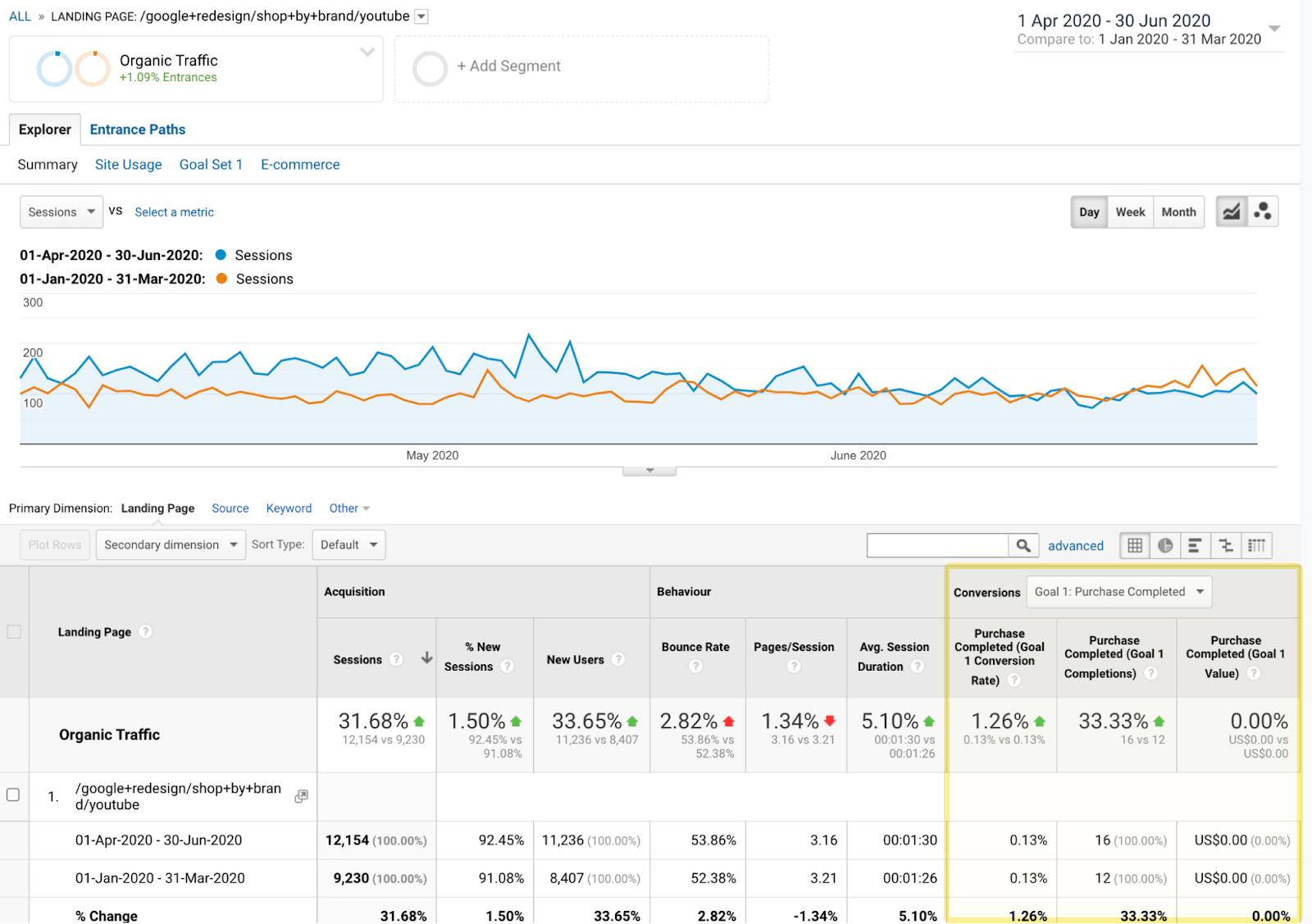
- Search visibility objectives – Set up a keywords tracking project in Ahrefs’ Rank Tracker and tag keywords relevant to the campaign.
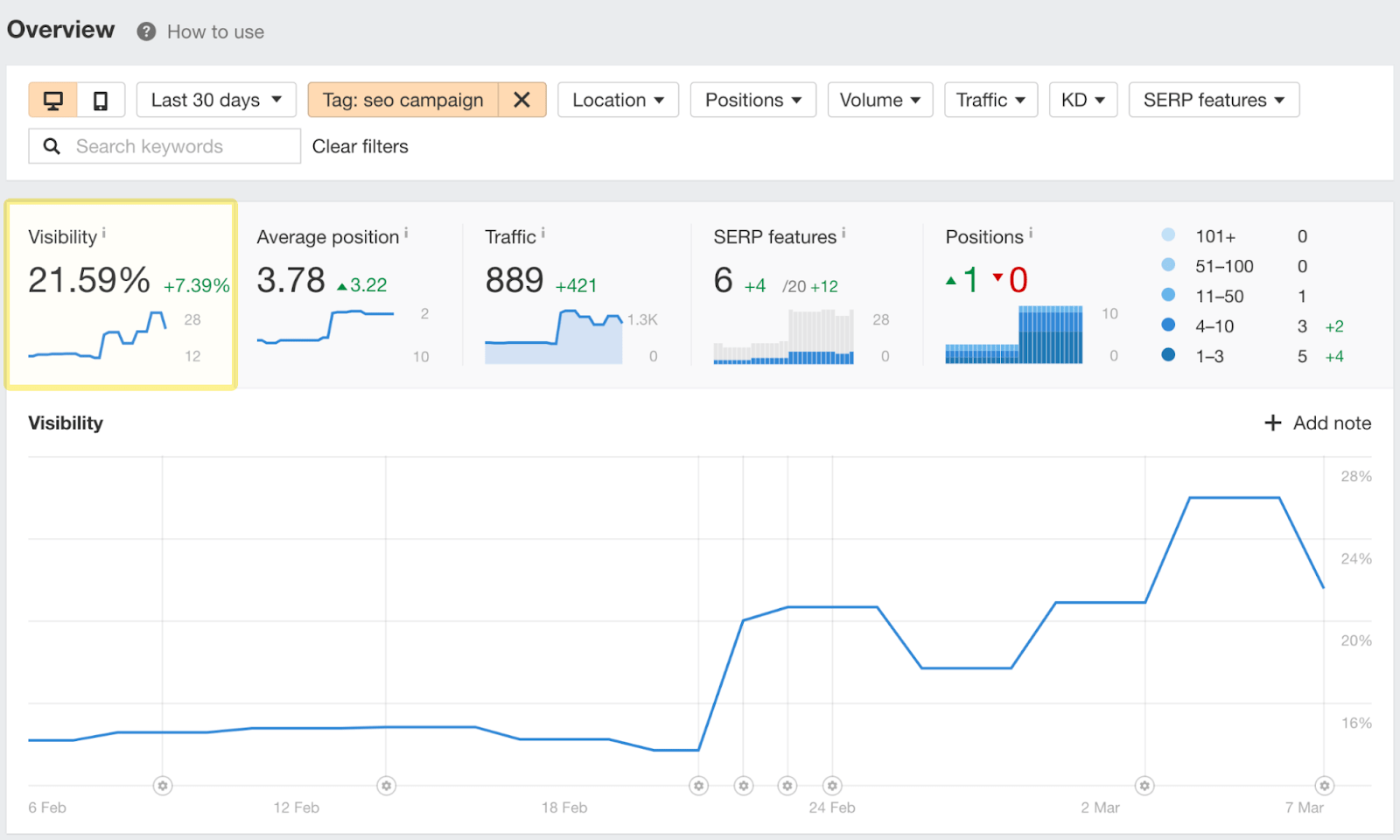
- Keyword rankings objectives – Keyword rankings in Ahrefs’ Rank Tracker or Organic keywords report for the campaign page in Ahrefs’ Site Explorer.
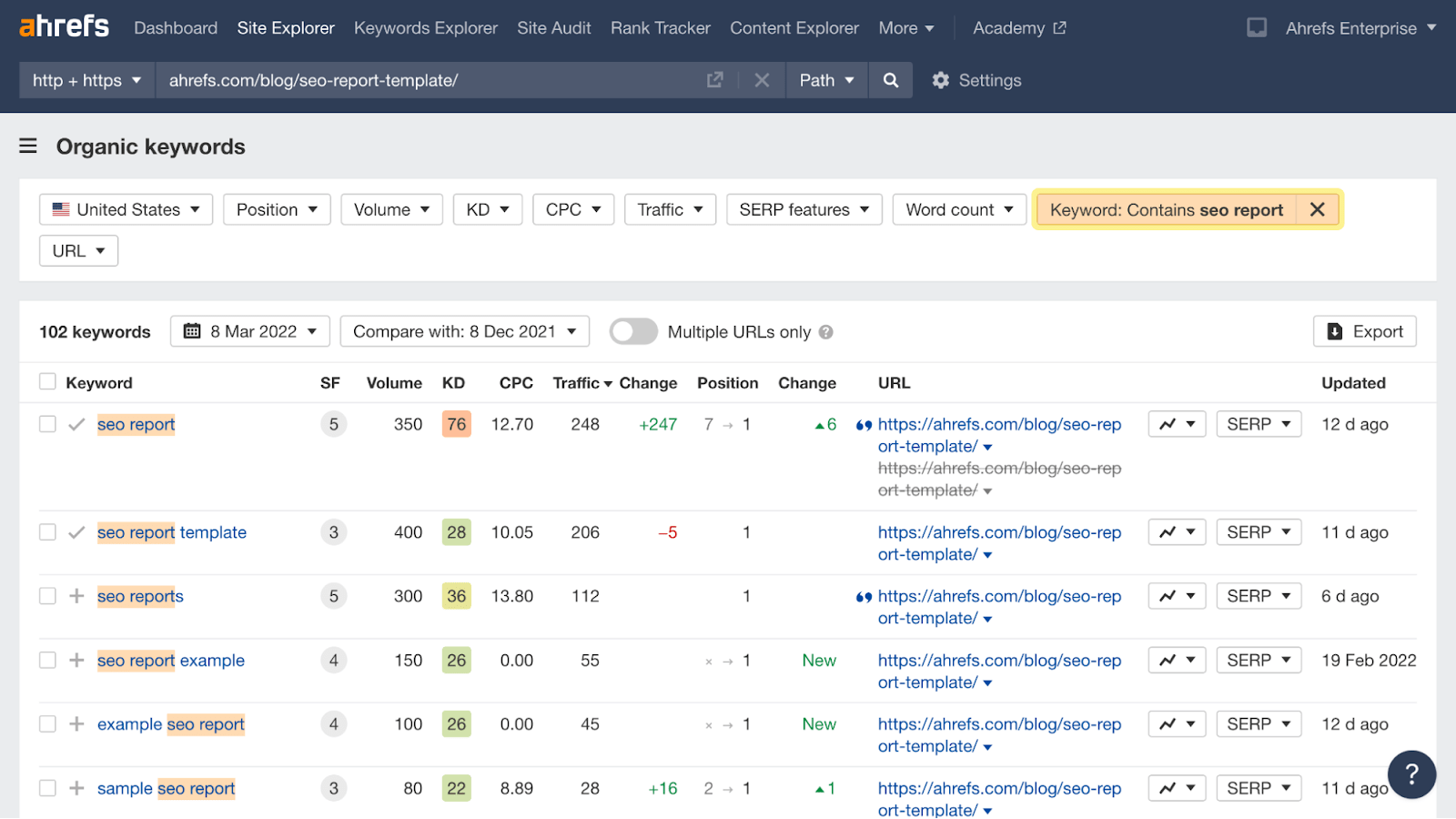
- Backlinks acquisition objectives – Backlinks and Referring domains reports in Ahrefs’ Site Explorer to check retrospectively. You can use Ahrefs Alerts to get regular backlink acquisition updates.

First of all, I recommend making notes during the campaign and right after it ends. Did it go as planned? Is it replicable? Can you use any of the processes in the future? What can you do better next time? You won’t recall all the details weeks or months later when it’s time to finally evaluate the campaign, so jot down what’s important as you go along.
If all the monitoring and tracking have been set up, you may find out that you achieved your campaign objectives sooner than expected. In this case, weekly checks should be fine. Anything more frequent than that isn’t necessary.
But as we all know, SEO can be quite volatile, so don’t celebrate just yet if you encounter better rankings for the first time.
When the rather arbitrary date of your campaign evaluation comes (e.g., rank top three for “seo statistics” within three months), look at the historical performance. If you see somewhat consistent higher rankings or higher sales over a longer period, you can finally wrap things up and tell yourself it’s been a successful campaign.
For example, the SEO stats page I was referring to throughout the article ranks at the top positions consistently. It also got to #1 in two months:

But if you don’t meet your objectives, don’t take it as a failure.
We do try and set up SMART objectives. But in all honesty, it’s often a guessing game in SEO, especially when it comes to estimating the period of when the effects of the campaign should kick in.
I was once involved in an SEO project where it took two years to achieve an objective that many people thought would be a question of just a few months.
Staying curious, being patient, and learning from mistakes are invaluable SEO skills.
Final thoughts
Properly planning, running, and evaluating big SEO campaigns requires advanced SEO knowledge, experience, and skills. But as we’ve shown in the article, you can also take part in smaller but still impactful campaigns like outreach campaigns or on-page optimization campaigns.
Start small, and you’ll eventually get to work on achieving the most ambitious SEO objectives.
A great benefit of launching SEO campaigns is that you’ll get better at project management and communication, as these campaigns often require the cooperation of many people—sometimes even outside of the marketing team.
Got any questions? Ping me on Twitter.
